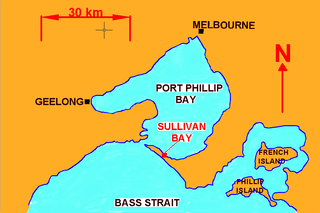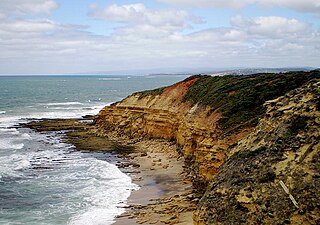
The Surf Coast Shire is a local government area in the Barwon South West region of Victoria, Australia, located in the south-western part of the state. It covers an area of 1,553 square kilometres (600 sq mi). It had a population of 32,251 in June 2018. It includes the towns of Aireys Inlet, Anglesea, Lorne, Moriac, Torquay and Winchelsea. It was formed in 1994 from the amalgamation of the Shire of Winchelsea, Shire of Barrabool and part of the former City of South Barwon, which was, at that point, part of the City of Greater Geelong.

Torquay is a seaside resort in Victoria, Australia, which faces Bass Strait, 21 km south of Geelong and is the gateway to the Great Ocean Road. It is bordered on the west by Spring Creek and its coastal features include Point Danger and Zeally Bay. At the 2021 census, Torquay had a population of 18,534.

Point Nepean marks the southern point of The Rip and the most westerly point of the Mornington Peninsula, in Victoria, Australia. It was named in 1802 after the British politician and colonial administrator Sir Evan Nepean by John Murray in HMS Lady Nelson. Its coast and adjacent waters are included in the Port Phillip Heads Marine National Park, while its land area is part of the Point Nepean National Park. The point includes Cheviot Beach on its southern side, notable as the site of the disappearance in 1967 of Australia's then-Prime Minister Harold Holt.

The Bellarine Peninsula is a peninsula located south-west of Melbourne in Victoria, Australia, surrounded by Port Phillip, Corio Bay and Bass Strait. The peninsula, together with the Mornington Peninsula, separates Port Phillip Bay from Bass Strait. The peninsula itself was originally occupied by Indigenous Australian clans of the Wadawurrung nation, prior to European settlement in the early 19th century. Early European settlements were initially centred on wheat and grain agriculture, before the area became a popular tourist destination with most visitors arriving by paddle steamer on Port Phillip in the late 19th century.
Pirra Homestead, in Windermere Road, Lara, Victoria, was built in the mid-1860s by George Fairbairn, one of Australia's most prosperous pastoralists and a pioneer of Australia's frozen meat export trade, who established the property as a premier sheep stud. The homestead was originally called 'Woodlands', but by 1880 the name of the property had changed to 'Windermere'.

Sullivan Bay lies 60 km (37 mi) due south of Melbourne on Port Phillip, one kilometre (0.6 mi) east of Sorrento, Victoria. It was established as a short-lived convict settlement in 1803 by Lieutenant-Colonel David Collins, who named the bay after the Under-Secretary of State for War and the Colonies, John Sullivan.
Point Impossible Beach is a clothes-optional beach located at Torquay, west coast, in the State of Victoria, Australia. It is designated as a legal nudist beach under the Nudity Act 1983.
Southside Beach is a clothes-optional beach located near Torquay, in Victoria, Australia. It is designated as a legal nudist beach under the Nudity Act 1983.

The City of South Barwon was a local government area in Victoria, Australia, which contained a number of Geelong suburbs south of the Barwon River, and extending to Torquay in the south and Barwon Heads to the east. The city covered an area of 165.4 square kilometres (63.9 sq mi), and existed from 1863 until 1994.

The Shire of Barrabool was a local government area about 100 kilometres (62 mi) southwest of Melbourne, the state capital of Victoria, Australia. The shire covered an area of 575.18 square kilometres (222.1 sq mi), and existed from 1853 until 1994.

The Joseph H Scammell was a Canadian sailing ship that was built at Eatonville, Nova Scotia in 1884 and shipwrecked at Point Danger, Torquay, Victoria, Australia in 1891. Her wreck triggered a large scale episode of shipwreck pilfering and smuggling.
The Port Phillip Bay and Bellarine Peninsula Ramsar Site is one of the Australian sites listed under the Ramsar Convention as a wetland of international importance. It was designated on 15 December 1982, and is listed as Ramsar Site No.266. Much of the site is also part of either the Swan Bay and Port Phillip Bay Islands Important Bird Area or the Werribee and Avalon Important Bird Area, identified as such by BirdLife International because of their importance for wetland and waterbirds as well as for orange-bellied parrots. It comprises some six disjunct, largely coastal, areas of land, totalling 229 km2, along the western shore of Port Phillip and on the Bellarine Peninsula, in the state of Victoria. Wetland types protected include shallow marine waters, estuaries, freshwater lakes, seasonal swamps, intertidal mudflats and seagrass beds.

Cape Parry is a headland in Canada's Northwest Territories. Located at the northern tip of the Parry Peninsula, it projects into Amundsen Gulf. The nearest settlement is Paulatuk, 100 km (62 mi) to the south, and Fiji Island is located 9 km (5.6 mi) to the west. Cape Parry was formerly accessible through Cape Parry Airport that was located at the Distant Early Warning Line. The airport was listed as abandoned after the closure of the DEW line site.

The Point Addis Marine National Park is a protected marine national park located near Anglesea on the Surf Coast region of Victoria, Australia. The 4,600-hectare (11,000-acre) marine park extends along 10 kilometres (6.2 mi) of coastline east of Anglesea, around Point Addis to the eastern end of Bells Beach and offshore 3 nautical miles to the limit of Victorian waters.

Point Danger is a headland on the coast of south-western Victoria, Australia. It lies at the western end of Portland Bay, on the northern side of Bass Strait, about 6 km south-south-east of the city of Portland. Cape Nelson lies 2.5 km to the south-west and the Lawrence Rocks 2 km to the south-east.
Torquay Airport is a privately owned airfield situated at 325 Blackgate Rd, Torquay, Victoria, Australia.

Point Avoid is a headland located at the south eastern extremity of both Coffin Bay Peninsula and Avoid Bay on the west coast of Eyre Peninsula in South Australia about 15 kilometres south west of the town of Coffin Bay. It was described in 2017 as being “fronted on all of its seaward sides by limestone cliffs, about 46 metres high, which change abruptly to sand hills E of its S(outhern) extremity.” It was named by Matthew Flinders on 17 February 1802 to acknowledge the navigational hazards present around its shores. The point is currently located within the boundaries of the protected area, the Coffin Bay National Park.
Aldinga Reef Aquatic Reserve is a marine protected area in the Australian state of South Australia located in waters adjoining the east coast of Gulf St Vincent including land within the intertidal zone in the suburbs of Aldinga Beach and Port Willunga about 40 kilometres (25 mi) south of the state capital of Adelaide.

Thorunna arbuta is a species of dorid nudibranch in the family Chromodorididae.

Margaret Brock Reef is a reef in the Australian state of South Australia located in the state's coastal waters on its south-east coast about 7 kilometres (4.3 mi) west of the headland of Cape Jaffa and about 27.2 kilometres (16.9 mi) south-west of the town of Kingston SE. It is the site of both a navigation aid which operated as a staffed lighthouse from 1872 to 1973 and as an automatic beacon onward to the present day, and a rock lobster sanctuary declared under state law in 1973. It is named after the barque Margaret Brock which was wrecked there in 1852.














